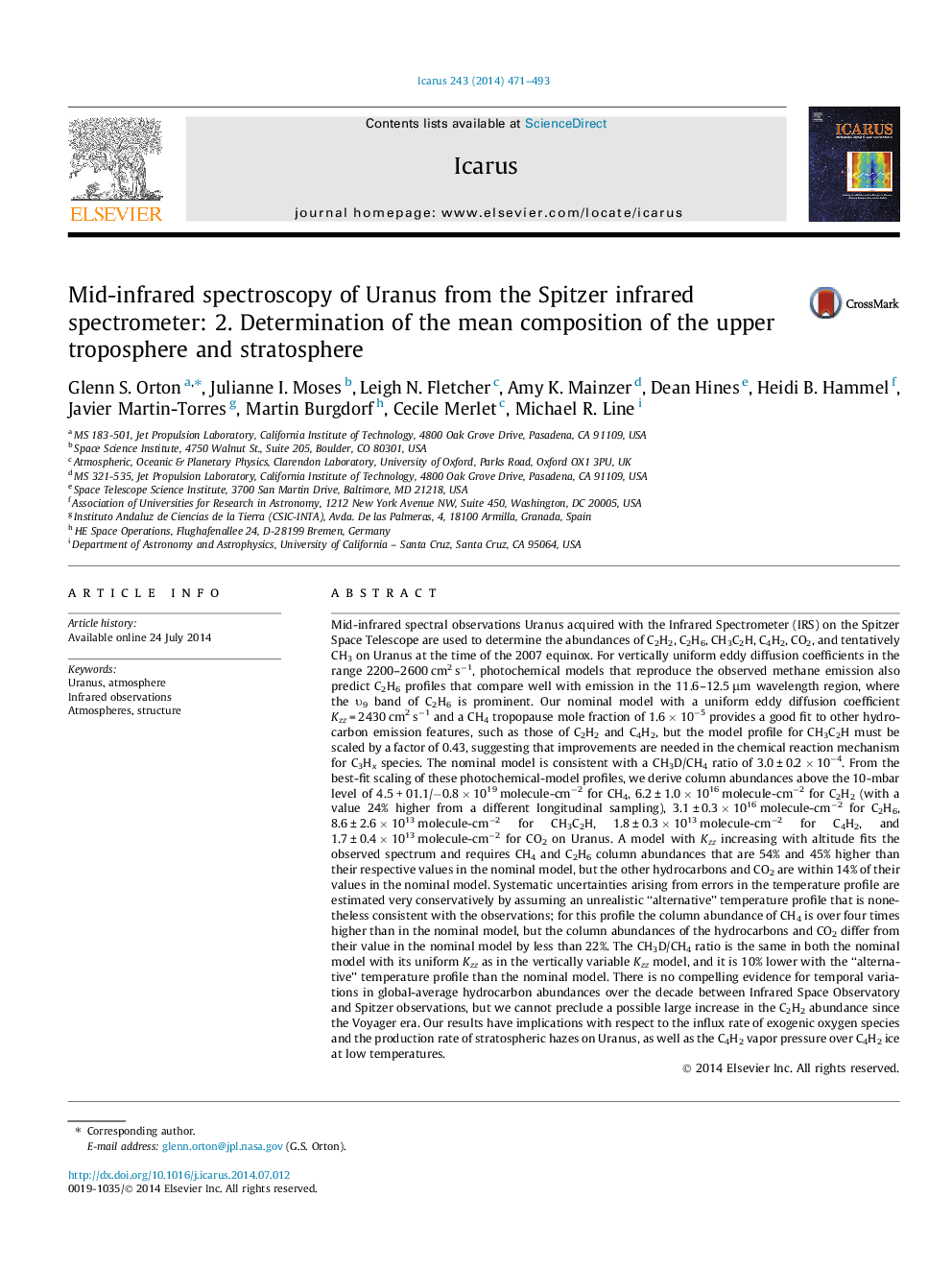| کد مقاله | کد نشریه | سال انتشار | مقاله انگلیسی | نسخه تمام متن |
|---|---|---|---|---|
| 1773112 | 1523547 | 2014 | 23 صفحه PDF | دانلود رایگان |
• 5–37 μm spectra of Uranus from the Spitzer IRS were analyzed for composition.
• Abundances of CH4, C2H2, C2H6, CH3C2H, C4H2 and CO2 were derived.
• Our results imply an extremely sluggish atmosphere compared with other outer planets.
• The upper atmospheric composition is dominated by oxygen-bearing constituents.
• The CH3D/CH4 ratio is 3.0 ± 0.2 × 10–4, consistent with independent measurements.
Mid-infrared spectral observations Uranus acquired with the Infrared Spectrometer (IRS) on the Spitzer Space Telescope are used to determine the abundances of C2H2, C2H6, CH3C2H, C4H2, CO2, and tentatively CH3 on Uranus at the time of the 2007 equinox. For vertically uniform eddy diffusion coefficients in the range 2200–2600 cm2 s−1, photochemical models that reproduce the observed methane emission also predict C2H6 profiles that compare well with emission in the 11.6–12.5 μm wavelength region, where the υ9 band of C2H6 is prominent. Our nominal model with a uniform eddy diffusion coefficient Kzz = 2430 cm2 s−1 and a CH4 tropopause mole fraction of 1.6 × 10−5 provides a good fit to other hydrocarbon emission features, such as those of C2H2 and C4H2, but the model profile for CH3C2H must be scaled by a factor of 0.43, suggesting that improvements are needed in the chemical reaction mechanism for C3Hx species. The nominal model is consistent with a CH3D/CH4 ratio of 3.0 ± 0.2 × 10−4. From the best-fit scaling of these photochemical-model profiles, we derive column abundances above the 10-mbar level of 4.5 + 01.1/−0.8 × 1019 molecule-cm−2 for CH4, 6.2 ± 1.0 × 1016 molecule-cm−2 for C2H2 (with a value 24% higher from a different longitudinal sampling), 3.1 ± 0.3 × 1016 molecule-cm−2 for C2H6, 8.6 ± 2.6 × 1013 molecule-cm−2 for CH3C2H, 1.8 ± 0.3 × 1013 molecule-cm−2 for C4H2, and 1.7 ± 0.4 × 1013 molecule-cm−2 for CO2 on Uranus. A model with Kzz increasing with altitude fits the observed spectrum and requires CH4 and C2H6 column abundances that are 54% and 45% higher than their respective values in the nominal model, but the other hydrocarbons and CO2 are within 14% of their values in the nominal model. Systematic uncertainties arising from errors in the temperature profile are estimated very conservatively by assuming an unrealistic “alternative” temperature profile that is nonetheless consistent with the observations; for this profile the column abundance of CH4 is over four times higher than in the nominal model, but the column abundances of the hydrocarbons and CO2 differ from their value in the nominal model by less than 22%. The CH3D/CH4 ratio is the same in both the nominal model with its uniform Kzz as in the vertically variable Kzz model, and it is 10% lower with the “alternative” temperature profile than the nominal model. There is no compelling evidence for temporal variations in global-average hydrocarbon abundances over the decade between Infrared Space Observatory and Spitzer observations, but we cannot preclude a possible large increase in the C2H2 abundance since the Voyager era. Our results have implications with respect to the influx rate of exogenic oxygen species and the production rate of stratospheric hazes on Uranus, as well as the C4H2 vapor pressure over C4H2 ice at low temperatures.
Journal: Icarus - Volume 243, 15 November 2014, Pages 471–493
